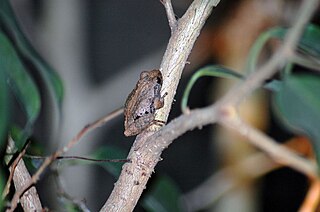
Philautus bombayensis, the Bombay bubble-nest frog, Maharashtra bush frog, Castle Rock bush frog, or Konkan bush frog is a species of frogs in the family Rhacophoridae. It is endemic to the Western Ghats, India.
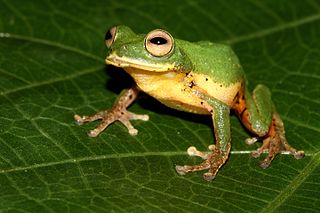
Raorchestes flaviventris is a species of arboreal, nocturnal, frog of the family Rhacophoridae. It is endemic to the Western Ghats, South India. Its common names are yellow-bellied bush frog and Malabar bubble-nest frog.

Raorchestes griet is a species of frog in the family Rhacophoridae. It is endemic to the Western Ghats south of the Palghat Gap in Kerala and Tamil Nadu states, India. The specific name griet honours Griet Decock, spouse of Franky Bossuyt, the scientist who described the species. The common name Griet bush frog has been coined for it.

Raorchestes nerostagona is a species of frog in the family Rhacophoridae. It is endemic to the Western Ghats, India. It has been called as the Kalpetta yellow bush frog or lichen bush frog for its patchy lichen like patterning that make it cryptic. First described in 2005 based on a specimen obtained in Kalpetta, the species has subsequently been found in many parts of the Western Ghats. This frog has been observed between 900 and 1200 meters above sea level.

Raorchestes munnarensis is a species of frog in the family Rhacophoridae endemic to Munnar, Kerala, along the Ghat road to Devikulam in the southern Western Ghats, India.
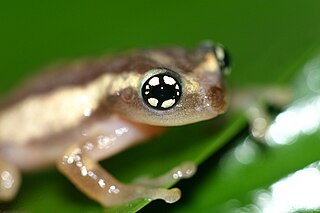
Raorchestes ochlandrae is a species of shrub frog in the family Rhacophoridae. It is endemic to the Western Ghats, India. This species of the oriental shrub frog was first described from Kakkayam Reserve Forest of Calicut district, Kerala state, in the southern Western Ghats in 2007 but has since been recorded at many other sites along the Western Ghats. The specific name ochlandrae refers to microhabitat of the species, bamboo Ochlandra setigera.

Raorchestes is a genus of frogs in the subfamily Rhacophorinae that are found in mountainous regions of South Asia, Southeast Asia, and southern China. A recent study places Raorchestes as a sister taxon of Pseudophilautus. Before the description of the genus in 2010, species now in Raorchestes had been assigned to genera Ixalus, Philautus, and Pseudophilautus.

Raorchestes kakachi is a species of frogs in the family Rhacophoridae. It is endemic to the southern Western Ghats of India. The specific name kakachi refers to the type locality from where the species was described.

Raorchestes chotta, also known as the small bushfrog or small bush frog, is a species of frog found only in Ponmudi in the Western Ghats of Kerala, India. This frog lays eggs attached to the underside of a leaf. They hatch as tiny froglets, skipping the tadpole stage. The frog has been observed between 600 and 980 meters above sea level.

Raorchestes jayarami, also known as Jayaram's bush frog, is a species of frog from the subfamily rhacophoridae found in Valparai in the Western Ghats of Tamil Nadu in India, where it has been observed between 600 and 1800 meters above sea level.

Raorchestes johnceei is a species of frog of the genus Raorchestes found in Bonacaud in the Western Ghats of Kerala in India. It has been observed between 900 and 1300 meters above sea level.

Raorchestes kadalarensis is a species of frog of the genus Raorchestes found in Kadalar near Munnar in the Western Ghats of Kerala in India. This frog has been observed between 1300 and 1700 meters above sea level.

Raorchestes archeos is a species of frog endemic to the Western Ghats of India. It is known from wet evergreen forests in the Agasthyamalai and Devarmalai ranges between Kerala and Tamil Nadu. It has been observed between 500 and 1071 meters above sea level.

Raorchestes hassanensis, the Hassan bush frog or Dutta's bubble-nest frog, is a species of frog in the family Rhacophoridae. It is endemic to India, including the Western Ghats.
Raorchestes primarrumpfi is a species of frog in the family Rhacophoridae. It is endemic to India and has been observed high in the Nilgiri Massif mountains.
Raorchestes archeos is a species of frog in the family Rhacophoridae. It is endemic to India, where it has been observed in the Western Ghat mountains at about 1524 meters above sea level.

Roarchestes blandus or the Anamalai bush frog is a species of frog in the family Rhacophoridae. It is endemic to India. Scientists have observed it in the Western Ghat mountains, between 45 and 806 meters above sea level.

The spiny bush frog is a species of frog in the family Rhacophoridae. It is endemic to India. It has been observed in the Western Ghat mountains, between 1464 and 1864 meters above sea level.
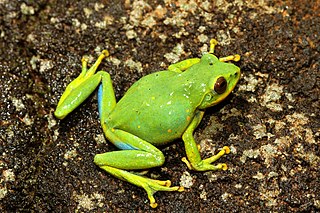
Roarchestes indigo is a species of frog in the family Rhacophoridae. It is endemic to India. It has been observed high in the mountains in scrub tree habitats. This frog has been observed between 1400 and 1700 meters above sea level.
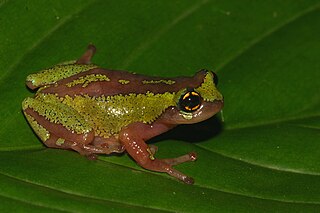
Raorchestes flaviocularis is a species of frog in the family Rhacophoridae. It is endemic to India. It has been observed between 1459 and 1569 meters above sea level in the Western Ghat mountains. It has been observed between 1400 and 1600 meters above sea level.


















